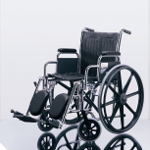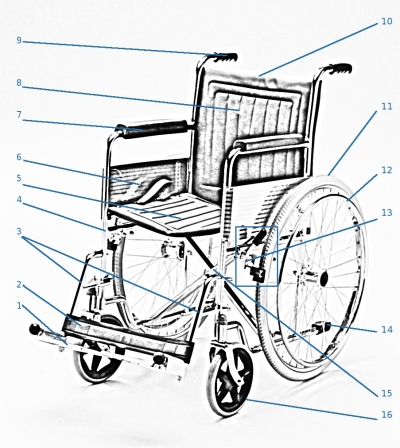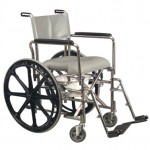The Wheelchair Guide
Your Wheelchair and Mobility Scooter Resource
Manual Wheelchairs vs Electric Wheelchairs
Monday, August 3rd, 2009
Wheelchairs are a popular mobility aid that greatly improves the lives of millions of people all over the world. The manual wheelchair has been around for thousands of years, while the electric wheelchair is relatively new, with the first electric wheelchair being developed in the early 1950′s. Choosing between a manual wheelchair or an electric wheelchair is an important decision that should be based upon the needs and requirements of its user.
Consider the Physical Capabilities of the User
One of the most important considerations when choosing between a manual or electric wheelchair is the physical abilities of the wheelchair user. Using a manual wheelchair requires a lot of upper body strength and can be very tiring even for someone who is in perfect health. In addition to having fairly good physical fitness, it is also necessary to use both arms to push a manual wheelchair.
An electric wheelchair, on the other hand, can be controlled by only using a single finger and there are also a number of other alternate controls as well. Alternate wheelchair controls include head controlled wheelchairs and breath controlled wheelchairs. This allows even someone with greatly reduced physical capabilities to use a wheelchair.
Consider Where the Wheelchair Will Be Used
In addition to considering the condition of the wheelchair user, it is also necessary to consider where the wheelchair will be used and how far it will be driven everyday. If the wheelchair is primarily going to be used around the home, then a manual wheelchair might be a good choice, because even though it requires a good deal of physical effort, moving between rooms does not present a very large traveling distance.
If, on the other hand, you intend to use the wheelchair away from home across a larger distance, an electric wheelchair might be a better choice. As an example, traveling across a college campus would be much more strenuous than traveling between rooms in a house. The per charge range of an electric wheelchair varies, but most can travel between 10 and 20 miles without needing to be recharged.
In addition to considering how far one will be traveling in the wheelchair, it is also important to consider what type of terrain will be traveled over. It takes much more effort to move up and down hills than it does to move across straight ground in a manual wheelchair. Some electric wheelchairs are also much better choices for off road use, although it is also possible to buy off road wheels for manual wheelchairs.
Consider the Cost of the Wheelchair
Finally, it is also important to consider the wheelchair users budget, when deciding between a manual wheelchair or an electric wheelchair. There are of course exceptions to the rule on both sides, but typically a manual wheelchair costs significantly less than an electric wheelchair. Usually a quality electric wheelchair costs between $3,500 and $7,000, while a manual wheelchair costs between $300 and $1,500.
When considering cost, it is important to take into account insurance programs, such as Medicare or Medicaid, which will often help to offset the cost of a wheelchair. For example, in the case of Medicare, typically 80% of the cost of the wheelchair is covered, so this can greatly offset the expense of an electric wheelchair.
Prescribing a Wheelchair: Follow Up Care
Monday, July 13th, 2009
 When a doctor prescribes a wheelchair to a user, it is very important that the wheelchair fits the needs of the user. It is also very important that the wheelchair user have a great deal of input over the process, because not only must their physical needs be met, but there are a number of other considerations, like where the person intends to primarily use their wheelchair, that should be considered.
When a doctor prescribes a wheelchair to a user, it is very important that the wheelchair fits the needs of the user. It is also very important that the wheelchair user have a great deal of input over the process, because not only must their physical needs be met, but there are a number of other considerations, like where the person intends to primarily use their wheelchair, that should be considered.
It is encouraged that new wheelchair users also talk with experienced wheelchair users and do a good deal of research on their own, because often doctors, while very well meaning, are not very experienced with wheelchairs and have never actually used one for an extended period of time. Due to health and safety concerns, it is very important that the wheelchair fits the physical requirements of the user.
Once the wheelchair arrives, everything should be remeasured and the wheelchair fully evaluated to ensure that it does in fact fit the needs of the user, however the doctors responsibility does not stop here. Instead, the wheelchair and its effect on the user should be reevaluated with each visit to the doctor.
One of the most important things that a doctor should look for is how the wheelchair is affecting the posture of its user. This is often something that can not be seen until after the user has been using the wheelchair for some time. Proper posture is essential for wheelchair users, because overtime a poor sitting position can cause a great number of health problems.
The actual condition of the wheelchair should also be checked and the user should be trained in how to properly maintain and care for their wheelchair. This includes lubricating moving parts, removing and cleaning the components, adjusting the anti-tip casters, and regularly checking the wheelchairs bolts for tightness. Emergency maintenance, such as how to fix a flat tire, should also be shown.
It is also very important that the wheelchair user be trained in how to navigate environmental factors that they might encounter. This includes the ability to move over curbs, navigate steps, and traveling on hills. Proper transfer techniques should also be shown and the user should be trained on how to fall out of the chair and recover. There are several places across the country that offer a sort of wheelchair obstacle course, to help train new wheelchair users and experienced wheelchair users alike.
The doctor should also make sure that the users home area is wheelchair friendly. It may be necessary to widen doors, install ramps, or a wheelchair lift. The doctor should talk with the patient and explain some of the options available.
Manual Wheelchair Parts Diagram
Monday, April 20th, 2009
Today, there are a number of different wheelchairs available, but the most common is the steel framed wheelchair. This type of manual wheelchair shares the E & J design, which was developed over eighty years ago, and is the type found in most hospitals. They are also referred to as Traditional wheelchairs, standard wheelchairs, or Conventional Wheelchairs.
Below, you will find a diagram of a traditional wheelchair and a list of its components. Click on any of the links to find out its description or you can scroll down the page.

- Footrest
- Legrest
- Front Rigging
- Frame
- Seat
- Metal Skirt
- Armrests
- Backrest
- Push Handles
- Push Axle
- Rear Wheels
- Handrims
- Brakes
- Tipping Lever
- Crossbars
- Caster Wheels
- Anti-Tip Casters (Not Pictured)
1. Footrest: The footrests, which are also called footplates and footpedals, can be adjusted to accommodate different lengths and can also be rotated.
2. Legrest: The legrest extends from the front of the wheelchair and the footrest is attached to the legrest.
3. Front Rigging: The front rigging refers to the footrest arm and the legrest as a single unit. In most conventional wheelchairs, the front rigging can be removed, but this is not always the case in less expensive models. It can also often be elevated to provide an elevated leg rest.
4. Frame: The conventional wheelchairs frame is made out of cold rolled steel that is chrome plated. The frame is the heaviest part of the wheelchair and it can weigh up to 50 pounds, but a stainless steel frame is also available that weighs about ten pounds less.
5. Seat: The seat, like the other fabric parts of a conventional wheelchair, is made from vinyl and uses a sling design. Multiple colors are often available and the vinyl fabric makes it very easy to clean.
6. Metal Skirt: The metal skirt is installed on either side of a conventional wheelchair between the armrests. It is designed to protect the users clothes from dirt, moisture, and debris that can be kicked up by the wheels. Metal Skirts also prevent the users clothes from becoming caught in the wheelchair.
7. Armrests: There are two types of armrests: Full length and Desk Type. The armrests are secured to the frame in two places and are designed to be very sturdy.
8. Backrest: The Backrest height is fixed and typically is about 16 ½ inches high. However, reclining backrests and extending backrest are available as options for most conventional wheelchairs.
9. Push handles: The Push Handles are located on the back of the wheelchair and rubber handles are installed to make them more comfortable.
10. Push Axle: The Push Axle ensures provides support for the push handles and is at a fixed height.
11. Rear Wheels: Typically the rear wheels will be 24 inches in diameter. Both Pneumatic and Solid tires are used. The rear wheels are used for manual propulsion of the wheelchair.
12. Handrims: The handrims extend outwards from the rear wheel. They are typically chrome plated and are used to propel the wheelchair.
13. Brakes: The brakes are located on the large rear wheels. They are typically located on the front of the wheel next to the bottom of the seat.
14. Tipping Lever: The tipping lever extends from the bottom of the frame and is designed to make it easier to move the wheelchair over obstacles, such as curbs. The person pushing the wheelchair will put weight on the tipping lever, which causes the wheelchair to tip backwards.
15. Crossbars: The crossbars are located under the seat and allow the wheelchair to be easily folded for storage and transportation. There are typically no locks to keep the conventional wheelchair from folding, but instead the weight of the user prevents the wheelchair from being folded.
16. Caster Wheels: The wheels of a conventional wheelchair are called caster wheels and are typically 8 inches in diameter. They are typically made of solid rubber, but for outdoor use pneumatic tires are recommended.
17. Anti-Tip Casters (Not Pictured): Anti-Tip Casters are not always present on conventional wheelchairs, but they can usually be added. They are designed to prevent the wheelchair from tipping over backwards. In the event that the wheelchair tips over too far, the anti-tip casters make contact with the ground, preventing it from completely tipping over.
The conventional wheelchair remains one of the most popular and recognized type of manual wheelchairs available. They are often available in a number of different colors and many offer features to make them easier to use, such as removable armrests to make transferring into and out of the wheelchair easier. They can be seen in public areas, like hotels, airports, grocery stores, and hospitals, which offer wheelchairs for their patrons to use.
The Beginning of the Modern Manual Wheelchair
Saturday, April 4th, 2009
 For most, the image of the manual wheelchair is very well known and the first thought when the word wheelchair is mentioned. They are also the oldest type of wheelchair, with records of manual wheelchairs dating back many thousands of years. Of course, these early wheelchairs looked a great deal different from the manual wheelchair of today.
For most, the image of the manual wheelchair is very well known and the first thought when the word wheelchair is mentioned. They are also the oldest type of wheelchair, with records of manual wheelchairs dating back many thousands of years. Of course, these early wheelchairs looked a great deal different from the manual wheelchair of today.
Some of the earliest records of wheelchairs date back to the early Asian empires and are known about only because of the images found by historians. These devices were often simply just wheeled carts and were even sometimes pulled by animals. As time progressed, the wheelchair would continue to develop, but there was not a real standard until the late 1800′s. Up until this point, wheelchairs came in many different sizes and often very cost prohibitive. In most cases, these early wheelchairs were only available to nobility, who had them custom built.
By the beginning of the 1900′s, a wicker wheelchair had become popular, but it was rather heavy to use and could not be self propelled. This changed with the development of the E & J wheelchair. The E & J wheelchair used hollow steel tubing to provide a strong, but lightweight frame. It could also be folded to take up less space and featured large wheels in the back. The wheels were designed so that the wheelchair user could propel themselves without assistance. Since the wheelchair could be folded and was so lightweight, it could be easily traveled with, making it very popular.
Around the same time that the E & J wheelchair was developed, World War II began. During the previous war, World War I, there had been a number of wounded soldiers, but due to the medical conditions, there was not that high of a survival rate. However, by the time World War II had began, there had been a number of improvements in medical care. One of the most important being the discovery of penicillin, which is a powerful antibiotic. As a result, there was large increase soldiers who survived as paraplegics. This increase would drive demand for the E & J wheelchair.
This early wheelchair would form the basis for the modern wheelchair and its basic design is still used today.. Its design being used in almost all forms of manual wheelchairs.